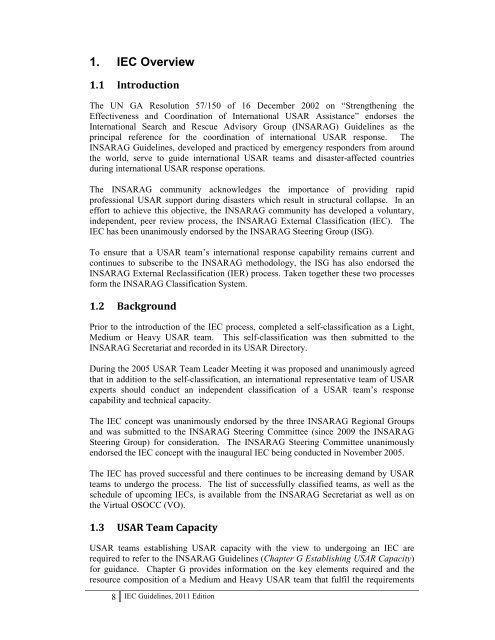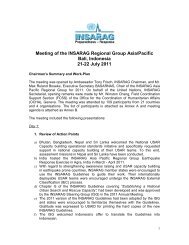INSARAG External Classification/Reclassification - Pacific Disaster ...
INSARAG External Classification/Reclassification - Pacific Disaster ...
INSARAG External Classification/Reclassification - Pacific Disaster ...
Create successful ePaper yourself
Turn your PDF publications into a flip-book with our unique Google optimized e-Paper software.
1. IEC Overview<br />
1.1 Introduction<br />
The UN GA Resolution 57/150 of 16 December 2002 on “Strengthening the<br />
Effectiveness and Coordination of International USAR Assistance” endorses the<br />
International Search and Rescue Advisory Group (<strong>INSARAG</strong>) Guidelines as the<br />
principal reference for the coordination of international USAR response. The<br />
<strong>INSARAG</strong> Guidelines, developed and practiced by emergency responders from around<br />
the world, serve to guide international USAR teams and disaster-affected countries<br />
during international USAR response operations.<br />
The <strong>INSARAG</strong> community acknowledges the importance of providing rapid<br />
professional USAR support during disasters which result in structural collapse. In an<br />
effort to achieve this objective, the <strong>INSARAG</strong> community has developed a voluntary,<br />
independent, peer review process, the <strong>INSARAG</strong> <strong>External</strong> <strong>Classification</strong> (IEC). The<br />
IEC has been unanimously endorsed by the <strong>INSARAG</strong> Steering Group (ISG).<br />
To ensure that a USAR team’s international response capability remains current and<br />
continues to subscribe to the <strong>INSARAG</strong> methodology, the ISG has also endorsed the<br />
<strong>INSARAG</strong> <strong>External</strong> <strong>Reclassification</strong> (IER) process. Taken together these two processes<br />
form the <strong>INSARAG</strong> <strong>Classification</strong> System.<br />
1.2 Background<br />
Prior to the introduction of the IEC process, completed a self-classification as a Light,<br />
Medium or Heavy USAR team. This self-classification was then submitted to the<br />
<strong>INSARAG</strong> Secretariat and recorded in its USAR Directory.<br />
During the 2005 USAR Team Leader Meeting it was proposed and unanimously agreed<br />
that in addition to the self-classification, an international representative team of USAR<br />
experts should conduct an independent classification of a USAR team’s response<br />
capability and technical capacity.<br />
The IEC concept was unanimously endorsed by the three <strong>INSARAG</strong> Regional Groups<br />
and was submitted to the <strong>INSARAG</strong> Steering Committee (since 2009 the <strong>INSARAG</strong><br />
Steering Group) for consideration. The <strong>INSARAG</strong> Steering Committee unanimously<br />
endorsed the IEC concept with the inaugural IEC being conducted in November 2005.<br />
The IEC has proved successful and there continues to be increasing demand by USAR<br />
teams to undergo the process. The list of successfully classified teams, as well as the<br />
schedule of upcoming IECs, is available from the <strong>INSARAG</strong> Secretariat as well as on<br />
the Virtual OSOCC (VO).<br />
1.3 USAR Team Capacity<br />
USAR teams establishing USAR capacity with the view to undergoing an IEC are<br />
required to refer to the <strong>INSARAG</strong> Guidelines (Chapter G Establishing USAR Capacity)<br />
for guidance. Chapter G provides information on the key elements required and the<br />
resource composition of a Medium and Heavy USAR team that fulfil the requirements<br />
8 IEC Guidelines, 2011 Edition




